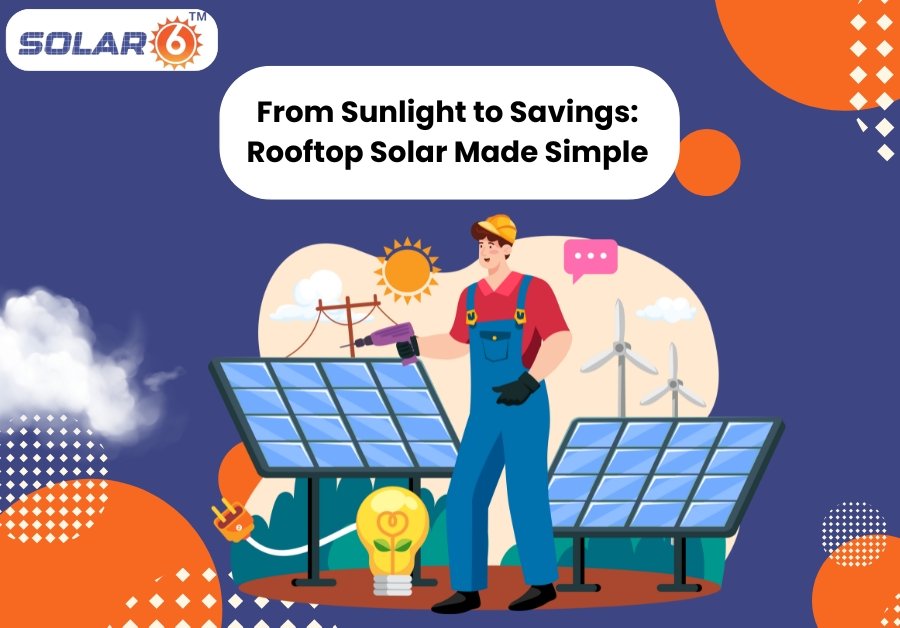As the world shifts toward sustainable living, rooftop solar panels have emerged as one of the most impactful, accessible, and clever solutions for smooth power. With growing electricity fees, developing environmental issues, and supportive government policies, more owners and organizations are embracing solar energy than ever earlier than. But notwithstanding the excitement, many still find solar power a complex topic, full of technical jargon, installation confusion, and uncertain savings. In this Article, Solar6 explains how to simplify the rooftop sun journey, guiding you from sunlight to savings with clear steps, Practical tips, and international insights.
The Power of Rooftop Solar Energy
Rooftop solar is a system of harnessing daylight using photovoltaic (PV) panels set up on the roof of a building. These panels convert sunlight into direct current (DC), which is then converted into alternating contemporary (AC) through an inverter, powering houses, workplaces, and industries. Solar energy is easy, renewable, and tremendous, reducing our dependence on fossil fuels and reducing greenhouse gas emissions. But past environmental blessings, rooftop sun offers actual financial advantages for families and companies alike.
In India, where sunlight is abundant for most of the year, rooftop solar holds huge potential. A 1-kilowatt (kW) device can generate up to four to five units of energy consistent with day. Over a month, that’s about 120–150 devices—enough to strengthen the average home. And in view that solar panels generally ultimate over 25 years, the long-term savings can be big.
Why Rooftop Solar Makes Financial Sense
One of the most important advantages of rooftop solar panels is the ability to cut power bills appreciably. Whether you’re a homeowner or business proprietor, switching to solar can cut back your monthly energy bills by 50% to 90%, depending on the scale of your device and your energy utilization patterns.
Let’s keep in mind an easy instance. If your common electricity bill is ₹3,000 in step with month, that totals ₹36,000 yearly. By installing a rooftop solar machine that offsets 80% of your usage, you may store nearly ₹29,000 consistently per year. Over 25 years, that’s greater than ₹7 lakhs in financial savings—even before thinking about rising grid energy prices. Add in authorities’ subsidies and net metering guidelines, and the ROI will become even greater appealing.
Net metering allows solar customers to feed extra energy back into the grid and obtain credits for it. This means if your panels generate more electricity than you use at some point in the day, you earn energy credit that offsets your utilization at night or at some stage in cloudy days.
How Simple Is It to Install Rooftop Solar?
Many people assume putting in solar panels is a complicated procedure; however, with the right guidance, it’s remarkably straightforward. The process generally includes the following steps:
System Design: Based on your energy usage and roof capacity, a customized solar system is designed with the ideal number of panels and inverter size.
Government Approvals & Subsidy Application: For residential installations, government approval and subsidy applications are often managed by your solar provider.
Installation: Skilled technicians install the panels, inverter, and wiring, usually within 2–5 days for residential systems.
Net Metering Setup: A bi-directional meter is installed to record both energy consumption and energy fed into the grid.
System Commissioning & Monitoring: Once live, you can monitor your energy production via a smartphone app or dashboard.
Many companies, including Solar6, offer end-to-end solutions—from site survey to installation and post-sales support—making the transition hassle-free.
Understanding Rooftop Solar Components
A rooftop solar power system typically includes several key components, each with a vital role in energy generation:
Solar Panels: These are the most visible part of the system. Made of monocrystalline or polycrystalline silicon, they capture sunlight and convert it into electricity.
Inverter: Converts DC electricity from the panels into usable AC electricity.
Mounting Structures: Hold the panels in place, angled for optimal sunlight exposure.
Batteries (optional): Store excess energy for use at night or during power outages.
Net Meter: Measures the inflow and outflow of electricity for net metering benefits.
Government Subsidies Make Solar More Affordable
The Indian government actively supports rooftop solar through initiatives like the PM Surya Ghar Yojana, which offers subsidies for residential solar installations. Under this scheme:
- A 1kW rooftop solar system receives a subsidy of ₹30,000.
- For 2kW systems, the subsidy is ₹60,000.
- For systems above 3kW, up to ₹78,000 can be availed.
These subsidies drastically reduce the upfront cost of installation, making solar energy accessible to the average homeowner. In addition to central subsidies, several Indian states offer their incentives, further lowering the total investment.
Solar for Homes vs Solar for Businesses
While rooftop sun offers massive advantages for house owners, industrial and commercial establishments stand to benefit even extra. Large roofs, higher energy needs, and regular utilization throughout the day make solar specifically useful for factories, offices, faculties, and department stores.
Businesses can reduce their operational costs, enhance energy independence, and demonstrate environmental responsibility—all while benefiting from tax incentives and government support. With net metering and scalable structures, commercial customers can offset a huge chunk of their electricity bills and reinvest the financial savings into business growth.
Maintenance and Monitoring—Is It Difficult?
Rooftop solar systems require minimal maintenance. Panels should be cleaned every 15–30 days to remove dust and debris, especially in dry or polluted areas. Inverter and battery components should be checked annually to ensure optimal performance.
Many modern systems come with remote monitoring apps, allowing you to track electricity production, detect issues, and monitor savings in real time. Solar6 provides ongoing customer support and annual service checks to keep your system performing at its best.
Environmental Impact of Rooftop Solar
Switching to solar isn’t just about saving money—it’s about saving the planet. Every kilowatt-hour (kWh) of solar power you generate reduces your carbon footprint. Over 25 years, a 3kW system can offset approximately 90 tons of CO₂ emissions, equivalent to planting over 1,400 trees or driving 3.5 lakh fewer kilometers in a petrol vehicle.
In cities where air pollution is a growing concern, solar panels represent a proactive step toward cleaner skies and healthier communities.
The Future of Rooftop Solar in India
India has set a bold goal of reaching 500 GW of renewable electricity capacity through 2030, with rooftop ssolarexpected to play a primary position. As extra humans undertake sun, charges are falling, technology are enhancing, and attention is developing. The future is honestly sun-powered.
Innovations like sun tiles, building-integrated photovoltaics (BIPV), and AI-based energy monitoring are already reshaping the rooftop solar landscape. With help from both the private sector and authorities, rooftop solar isn’t just a fashion—it’s a revolution.
Solar6: Your Trusted Rooftop Solar Partner
Solar6 stands at the vanguard of India’s solar revolution, presenting first-rate solar panels, professional setup, and lifelong support. With a dedication to innovation, affordability, and customer delight, Solar6 makes your transition to solar easy, smooth, and stress-free.
Whether you want to electrify your house, your business, or your complete apartment building, Solar6 affords custom-designed solutions tailor-made for your needs. With reliance on engineering, transparent pricing, and the current era, the journey from sunlight to financial savings has by no means been less difficult.
Final Thoughts
The shift to rooftop solar is no longer a luxury; it’s a smart necessity. With soaring strength prices, environmental concerns, and abundant sunshine, India is flawlessly placed to steer the solar revolution. And for people, making the switch means a long time of easy electricity, lower payments, and peace of mind.
From consultation to installation to long-term support, the process can be simple when guided by professionals like Solar6. So, if you’ve been waiting for the right time to embrace solar energy, the sun is shining brighter than ever. Make the switch. Save money. Save the planet.

